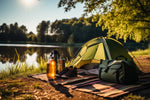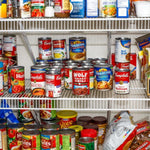Patrick Kelley
Emergency Steps to Take Before, During and After a Disaster
Protect your family in any emergency with a foolproof contingency plan
People who escape natural catastrophes can consider themselves lucky. But, surviving a disaster takes more than just luck. It takes emergency preparedness before the unthinkable happens. It takes quick decision-making and unwearied vigilance during and after the emergency. These undeniable factors for survival ultimately decide your fate.
Depending on where you live, you may be facing the imminent peril of hurricanes, earthquakes or floods. These disasters usually come with terrible sidekicks like fires, landslides and power blackouts. Sometimes they even set up the perfect grounds for a disease outbreak.
You need to implement proper emergency preparedness measures to survive any possible calamity scenario. This short guide should clear the air on how to act before, during and after a disaster.
Have a General Disaster Preparedness Plan
If you live in a region that is susceptible to several potential natural disasters, it doesn't pay off having a plan for each of them. If there is a chance that you will be fighting earthquakes, hurricanes, and floods, you better have a general disaster plan, which should include these measures:
- Have safe storage of food and water that your family can consume for at least two months
- Have a safe room/shelter on your property, if the area size allows it
- Keep important documents, IDs, and certificates in a portable, fireproof safe
- Have a good stock of clothing and bedding ready to use in an emergency
- Keep a set of flashlights, tools and kitchen utensils in a portable, ready-to-go set
- Have a medical kit containing first aid supplies and specific medication for your loved ones
- Invest in survival kits consisting of food, water, medicine, and life-saving tools, and which can keep one safe and alive for at least 72 hours. Have one ready at all times for each member of your family.
These emergency preparedness measures should help you increase your survival chances before a disaster situation. To enhance their viability, you should run regular drills with your family. Frequent exercises will ensure that everyone remains calm and knows what to do when a calamity arrives on the front porch.
How to Survive a Hurricane
Hurricanes are some of the most unforgiving natural disasters that can hit your area. Such a calamity usually destroys entire communities including people's lives, their houses, and the public grid.
The only good part about a hurricane is that you know about it in advance. Usually, you get between 3 and 5 days to prepare before it hits. Here is what you can do before, during and after a hurricane!
Before
- Ensure that your general emergency preparedness kit is updated and set in order
- Prepare your property by strengthening fences and structures
- Remove any outside furniture or clutter in your yard that could turn into projectiles during the hurricane
- Board up windows and doors with sturdy wooden panels
- Define a potential evacuation route
- Stay in touch with the local authorities about community shelters where you can retreat if you have to leave your home
During
- Monitor the news to understand the evolution of the storm
- Stay put in your shelter unless the authorities employ an evacuation plan
- If you are being evacuated, you should obey the orders of the authorities and follow the evacuation route
After
- Stay in your shelter until the authorities signal that it is safe for you to come out
- Monitor the weather to take shelter from minor storms that usually follow hurricanes
- Avoid using the power grid, the gas line or drinking tap water. The hurricane might have damaged these systems
- Remove the clutter from your property, and help the others in your community to recover
- Inspect your emergency preparedness kits and restock if necessary
How to Survive an Earthquake
One natural disaster that is almost impossible to predict ahead is the shaking of Earth’s surface. Earthquakes range in intensity from the least noticeable ones to those that destroy entire cities and kill thousands of people. The stronger ones take just a few seconds to turn an entire metropolis to dust and rubble.
If you live in an area with frequent seismic activity, here is what you should do before, during and after an earthquake!
Before
- Ensure that your 72-hour survival kits are always handy
- Strengthen any structures in your home that may break during a tremor
- Make sure that the path to your shelter/safe room is free of clutter at all times
During
- Take shelter under a sturdy piece of furniture
- If you are indoors, stay put. Going outside may decrease your chances of survival
- Stay away from windows
- If you are in a vehicle, stop safely in an open space and far from any tall structures
After
- Stay put or get to a better-sheltered area in your home as aftershocks usually follow
- Shut off the gas, water and electricity lines in your home to avoid potential accidents
- Get away from hazardous structures that have may have been damaged
- Monitor the news to find out if evacuation is necessary or not
- If you are trapped under debris, try to make as much noise as possible so that the disaster relief squads can find you
How to Survive a Flood
Floods are a bit more predictable than earthquakes, but you get less time to prepare than when a hurricane hits. Generally, if you live in an area that it is susceptible to flooding, the local authorities can alert the population with as much as two days in advance. Here is what you should do before, during and after a flood!
Before
- Assess the situation of your property and determine whether it can survive a flood
- Board up the entrances to your basement, cellar or underground shelters
- Remove any outside furniture from your yard
- Take any outdoor pets or domestic animals that you have to safety
- If you have a multiple-story home, transfer all the important belongings to a higher level
- Ensure that the roof hatch to your roof works and that you can use it as an escape route
- If you have to leave home, turn off all your utilities and board up all the windows and the doors
During
- Monitor the news to find out the evolution of the flood
- Stay put in your home unless the authorities employ an evacuation plan
- If you are being evacuated, you should obey the orders of the authorities and follow the evacuation route
After
- Keep monitoring the news. Floods may also bring landslides or fires as a result of grid line damage
- Avoid going outside until the level of water drops to a safe height
- Do not use the flood water for any purpose. It may be contaminated with chemicals or toxins from dead animals
- If you had to evacuate before the flood, do not return to your home until the authorities deem it a safe area
Share on:









